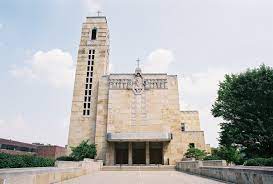The 1920’s saw a growing number of Catholics building homes on the eastern fringe of Columbus, encouraging the Rt. Rev. Bishop James Joseph Hartley, Presiding Bishop of the “Columbus Diocese”, to announce the formation of the new St. Catharine’s Parish in May, 1931.1 From the very beginning, St. Catharine was both a house of worship and an elementary school. The Rev. Robert F. Coburn was appointed to lead the new parish. Bishop Hartley pontificated at the dedication of the temporary chapel/school on September 13, 1931.

With a parish numbering 491 men, women and children, the school opened in the Fall with four nuns of the Holy Cross Sisters of Mt. Carmel conducting classes through the 6th Grade, with 7th and 8th grades added the following year. The Sisters lived at Mt. Carmel Hospital until 1938, when a new convent was provided for ten sisters on the parish grounds. They lived there until June 21, 1974, when the Sisters ceased their role in the school.
With an expanding student population, a new eight classroom brick building was erected facing Fair Avenue, in 1950. In addition, there were meeting rooms, a library, and a cafeteria. Ten years later six additional classrooms were added. By 1959, sketches were being circulated for a permanent church building. Construction was completed in time for the first mass to be offered midnight Christmas, 1961. The church designed and planned by architects Ramsey and Croce and constructed by Altman-Coady Co. is made of St. Meinrad sandstone, trimmed with Indiana limestone.
In reviewing the book published in 1981, 50 Years at St. Catharine, by Tom Keys, noted sports editor of the former Columbus Citizen-Journal, I was reminded of the family participation in the many facets of church life that nurtured the early growth of the parish. The Altar Rosary Society was instrumental early in organizing much of this. Along with the primary goal of caring for the altars, there were committees working on Catholic charities, family welfare, and social activities.
Speaking of the first organizers of the Altar Rosary Society, Keys says, “Mrs. Sells, aided by other pioneer members of the parish, raised money to buy vestments, linens, cruets, etc., through socials and card parties at the homes of Mrs. Clem Smeltzer, Mrs. John Seidensticker, Mrs. James Sugar, Mrs. Leo Rodenfels, Mrs. Sells and others.”2
The forerunner of the present Athletic Association was the Bexo Club. It had as one of its earliest goals providing a proper athletic field, that was dedicated August 25, 1945. Quoting from Tome keys, “Some of the more active members were Joe and Mike Ryan, Jim Grace, John S. Connor, Henry Ruhl, James Kramer, Dan and Jack Cannon, Al Reitelbach, Tom Buchanon, Ed Abram, E. Faber Biggert, Dalton Mulloney and Florian Ziegler.”3
St. Catharine continues to play a prominent role in the lives of its parishioners. The Annual Parish Festival, the second weekend of June, is a popular community event. Monsignor Sorohan, current pastor, noted that lay leadership has grown through such bodies as the Parish Council, Administrative Committee and Finance Committee. He brings to his present position ten years experience as Superintendent of the Columbus Diocese Schools, followed by Vicar for Education, authorized to speak for the Bishop on educational matters. There are now 1,250 families in the parish and 275 students – kindergarten through 8th grade.4
Adapted from article By Edward L. Hamblin
Bexley Historical Society President, 1997-2002
Originally published in Historical Herald, November 1998
If you have information to add to this topic, please let us know.
All comments are reviewed before posting.
1 Information on the history of St. Catharine’s Parish is from Tom Keys’ book 50 Years at St. Catharine
2 Ibid., 57
3 Ibid., 66-67
4 A number of interesting insights were conveyed by Monsignor Sorohan in his interview with Ed Hamblin
